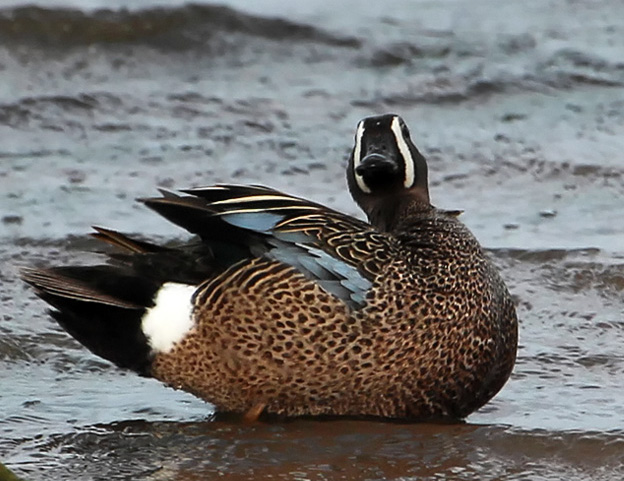By John Shackford

The Blue-winged Teal (Anas discors) is one of the dabbler ducks—ducks that feed by swimming on the surface of ponds with their bills open, the bottom part of their bill being underwater; occasionally they feed a little deeper by tipping downward, with their rumps in the air. But generally speaking they are not diving ducks.
Identification of the adult male Blue-wing in breeding plumage is not too tricky. They are one of the smaller ducks and show a strong white crescent between bill and eye on a gray face. In flight, they show a blue wing patch; this blue patch is usually hidden when the bird is at rest on the water. But males during other part of the year, females and young are trickier to identify. In addition to being small and showing the blue wing patch, they show a little lightness of plumage between the bill and eye that goes downward toward the throat. But this is not a lot to go on—and it is good to consult your field guide. Where there is the possibility of a Cinnamon Teal female or young, they are nearly indistinguishable from female and young Blue-wings, although the male Cinnamon, with his overall cinnamon color, is unmistakable.
As an Oklahoma bird species, Dr. Sutton (1967. Oklahoma birds) says that the Blue-wing is a “transient seen chiefly from mid-August to mid-November and from early March to late May; nests occasionally” but “winter records (December 18 to February 26)” do occur. Thus, the Blue-winged is primarily a migrant in the state. Several authors point out that this duck is less hearty than most of our other duck species.
The rarity of Blue-wings in winter brings up a point about any rare bird reports on a Christmas Bird Count (CBC). An occasional erroneous report of a rare bird does not greatly damage the total report of species for that CBC. This is because the most important data from a CBC for researchers involves fluctuating numbers of expected species on a count. A rare bird is always quite fun to find, and may be an important harbinger of things to come. But also a rare bird may just be handicapped in some way—perhaps injured from flying into a window, having a broken or injured wing, having a disease, or just being an old, weak bird.
Another possibility for some of the wayward birds we find during the year might be related to some research I saw several years ago. The research was done on small migratory birds, but I do not know why it would not apply to larger migratory birds like the Blue-wing as well. It was data from a surprisingly simple experiment. Small migratory birds were put in a cage that had an ink pad on the bottom, and sloped light-colored paper partway up the sides of the cage. Then these birds were shown correct images of the nighttime sky. Most of the birds of a species would jump repeatedly in one particular direction, thus revealing, apparently, the “normal” migratory response for that species. But on rare occasions, a particular bird would most often jump in the opposite direction (call it a rare “exceptional” bird, instead of a common “normal” bird), as revealed by the repeated ink scratch marks it made on the sloped paper. A possible example of this in the real world and using warblers rather than ducks for the moment, is the eastern warbler records that seem every year to show up at Point Reyes on the west coast of California. Some of these rarities may be the “exceptional” warblers that turned in the “wrong” migratory direction, ending up on the west coast, rather than in the eastern U. S, where they “belonged”.
Getting back, specifically, to Blue-wingeds, the only nesting record I have any personal recall of for the state occurred in northwestern Oklahoma, in Harper County. Laurence Dunn, who was a long-time member of the Oklahoma Ornithological Society, showed me the spot where a Blue-wing had flown off a nest in a wheat field that he had harvested. I was very surprised to see how far the nest site was from the nearest water, a pond at least 200 yds. away; if the eggs had hatched before the wheat was harvested, the adult birds would have had quite a walk to lead young through the tall wheat to the pond. I had always assumed that virtually all duck nests were fairly close to water, an erroneous assumption, apparently, on my part. The number of eggs laid in a Blue-wing nest are usually between 8-12, but sometimes 6-16; incubation is usually 24-25 days and is done by the female alone.
